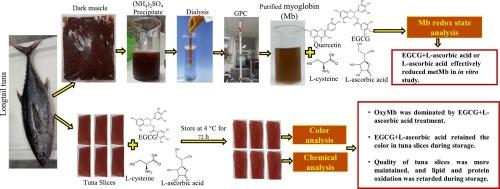多酚与 L-半胱氨酸/l-抗坏血酸结合使用的效果:冷藏长尾金枪鱼(Thunnus tonggol)切片的肌红蛋白氧化还原状态、颜色和质量
IF 5.4
2区 医学
Q2 MATERIALS SCIENCE, BIOMATERIALS
引用次数: 0
摘要
研究了酚类化合物与 L-半胱氨酸/l-抗坏血酸对肌红蛋白(Mb)氧化还原状态的影响,以及它们对保持冷藏长尾金枪鱼(Thunnus tonggol)切片的颜色和质量的功效。在 4 ℃条件下,将纯化的高铁血红蛋白(metMb)和氧高铁血红蛋白(oxyMb)样品单独或与 L-半胱氨酸(CT)或 l-抗坏血酸(AA)一起加入表没食子儿茶素-3-棓酸盐(EGCG)或槲皮素。EGCG与AA的组合(EGCG+AA)和单独与AA的组合均能显著降低甲硫氨酸镁的水平,提高甲氧氨酸镁的水平(p < 0.05)。此外,与其他处理过的金枪鱼切片相比,EGCG+AA(分别为 200 mg/kg 和 200 mg/kg)处理过的金枪鱼切片具有更好的保色性(高 a* 值和 a*/b*),并能更有效地减少脂质和蛋白质氧化。单独使用 AA 对保持切片颜色和质量的效果较差。因此,EGCG+AA 能有效保持在 4 °C 下储存的金枪鱼切片的颜色和质量。本文章由计算机程序翻译,如有差异,请以英文原文为准。

Effects of polyphenols in combination with L-cysteine/l-ascorbic acid: Myoglobin redox state, color and quality of refrigerated longtail tuna (Thunnus tonggol) slices
Effects of phenolic compounds in conjunction with L-cysteine/l-ascorbic acid on the redox state of myoglobin (Mb) and their efficacy to maintain the color and quality of refrigerated longtail tuna (Thunnus tonggol) slices were investigated. Purified metmyoglobin (metMb) and oxymyoglobin (oxyMb) samples were added with Epigallocatechin-3-gallate (EGCG) or Quercetin individually or in combination with L-cysteine (CT) or l-ascorbic acid (AA) at 4 °C. EGCG in combination with AA (EGCG+AA) and AA alone significantly reduced metMb and increased oxyMb levels (p < 0.05). Furthermore, the slices of tuna were treated with EGCG+AA (200 and 200 mg/kg, respectively) exhibited superior color retention (high a* value and a*/b*) and reduced lipid and protein oxidation more potentially, compared to other treated slices. AA alone was less effective in preserving color and quality of slices. Therefore, EGCG+AA effectively maintained the color and quality of tuna slices stored at 4 °C.
求助全文
通过发布文献求助,成功后即可免费获取论文全文。
去求助
来源期刊

ACS Biomaterials Science & Engineering
Materials Science-Biomaterials
CiteScore
10.30
自引率
3.40%
发文量
413
期刊介绍:
ACS Biomaterials Science & Engineering is the leading journal in the field of biomaterials, serving as an international forum for publishing cutting-edge research and innovative ideas on a broad range of topics:
Applications and Health – implantable tissues and devices, prosthesis, health risks, toxicology
Bio-interactions and Bio-compatibility – material-biology interactions, chemical/morphological/structural communication, mechanobiology, signaling and biological responses, immuno-engineering, calcification, coatings, corrosion and degradation of biomaterials and devices, biophysical regulation of cell functions
Characterization, Synthesis, and Modification – new biomaterials, bioinspired and biomimetic approaches to biomaterials, exploiting structural hierarchy and architectural control, combinatorial strategies for biomaterials discovery, genetic biomaterials design, synthetic biology, new composite systems, bionics, polymer synthesis
Controlled Release and Delivery Systems – biomaterial-based drug and gene delivery, bio-responsive delivery of regulatory molecules, pharmaceutical engineering
Healthcare Advances – clinical translation, regulatory issues, patient safety, emerging trends
Imaging and Diagnostics – imaging agents and probes, theranostics, biosensors, monitoring
Manufacturing and Technology – 3D printing, inks, organ-on-a-chip, bioreactor/perfusion systems, microdevices, BioMEMS, optics and electronics interfaces with biomaterials, systems integration
Modeling and Informatics Tools – scaling methods to guide biomaterial design, predictive algorithms for structure-function, biomechanics, integrating bioinformatics with biomaterials discovery, metabolomics in the context of biomaterials
Tissue Engineering and Regenerative Medicine – basic and applied studies, cell therapies, scaffolds, vascularization, bioartificial organs, transplantation and functionality, cellular agriculture
 求助内容:
求助内容: 应助结果提醒方式:
应助结果提醒方式:


